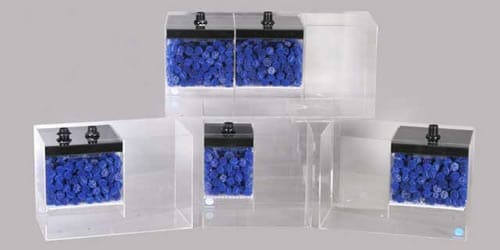Wet Dry Filter FAQ
One of the most important aspects of keeping an aquarium is filtration. Wet/Dry Filters with Bio-Balls are some of the most debated and popular products sold in fish specialty stores and online. But the question everyone asks is, “Do Bio-Balls and Wet/Dry Filters Work, or am I Wasting My Money?”
About Wet Dry Filters
The answer is, “It Depends” on the application. A Bio-Ball is a small plastic ball with many pores where bacteria can grow to break down ammonia and nitrite. Unfortunately, Bio-Balls are not able to grow anaerobic bacteria that break down nitrate. As a result, an aquarist using Bio-Balls will typically have undetectable ammonia and nitrite, but will have difficulty maintaining low nitrate levels.
How Does A Wet Dry Filter Work?
To better control nitrates and increase filtration, the hobbyist should perform routine water changes, implement a sand bed, live rock, or refugium filtration system, or add a protein skimmer in combination with the Wet/Dry Filter. It is also necessary to keep the Bio-Balls from clogging with detritus, as this can hinder their ability to filter; this also goes for Bio-Wheels. In a typical Wet/Dry Filter or Bio-Tower, place a pre-filter or filter sock before the Bio-Balls to collect the detritus. Replace and clean the filter pad as it becomes dirty.

Aquarium Bio-Balls
Keeping the Bio-Balls clean can be a lot of work, why would anyone want to use Bio-Balls? When working properly, Bio-Balls are excellent at breaking down ammonia and nitrate. They can also be used in the sump or overflow box to prevent micro bubbles from entering into the return pump and back into the aquarium. Another alternative to Bio-Ball filtration is Rubble Live Rock filtration. Replacing Bio-Balls with small pieces of Live Rock can provide both aerobic and anaerobic bacteria. That is if the Rubble Live Rock contains pores free of oxygen where anaerobic bacteria can form and break down nitrates. One disadvantage of using Live Rock is it can become clogged more quickly than Bio-Balls, due to the small holes.
Bio-Balls can be a powerful tool in reducing ammonia and nitrites, but should not be the primary source of filtration. Instead, Wet/Dry Filters should be used in combination with another filter source, like a Protein Skimmer or refugium to keep nitrates under control.
